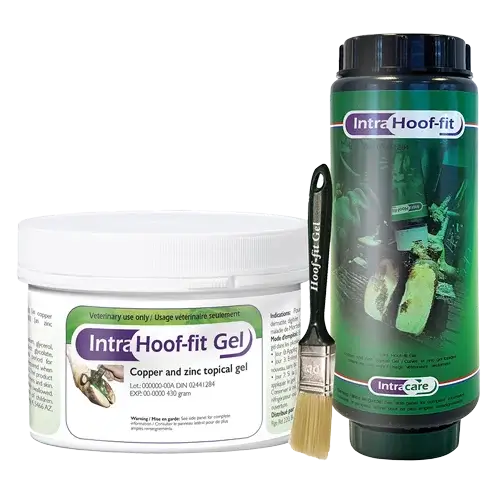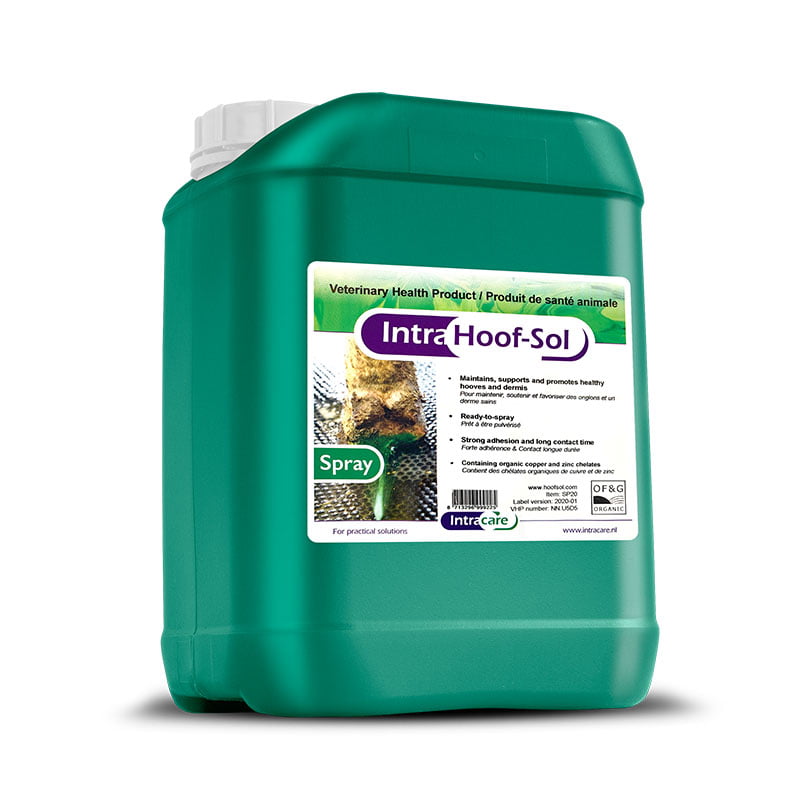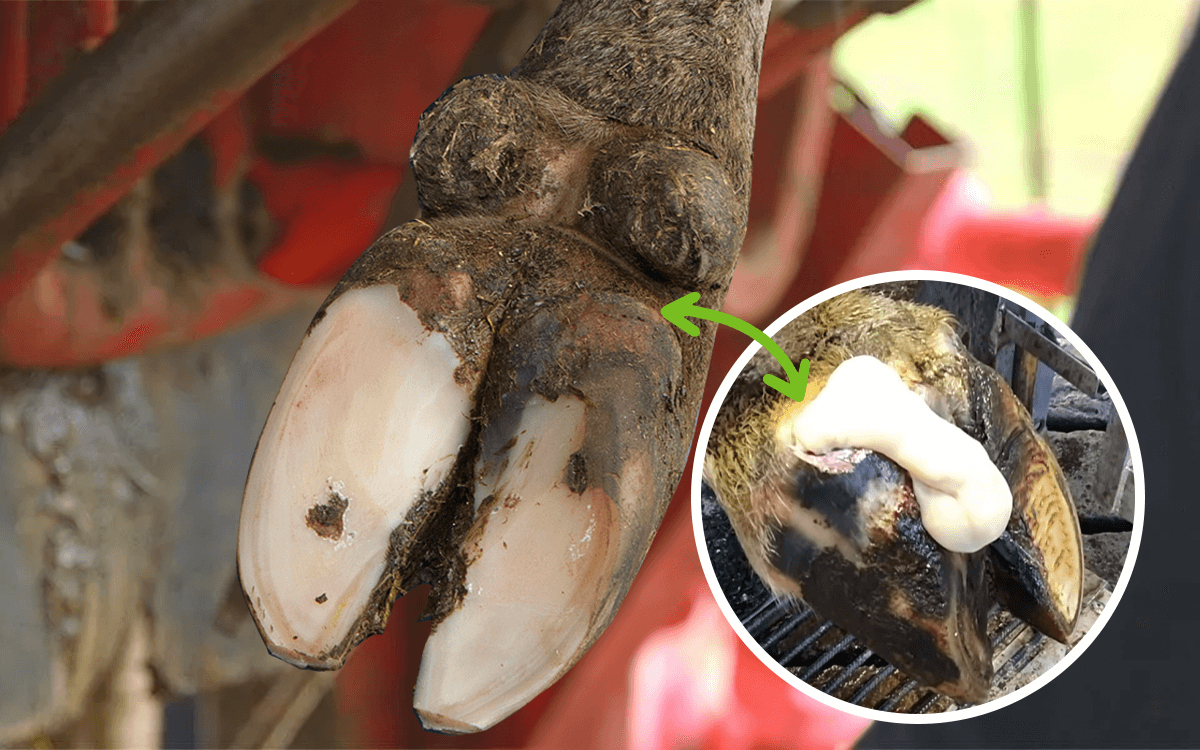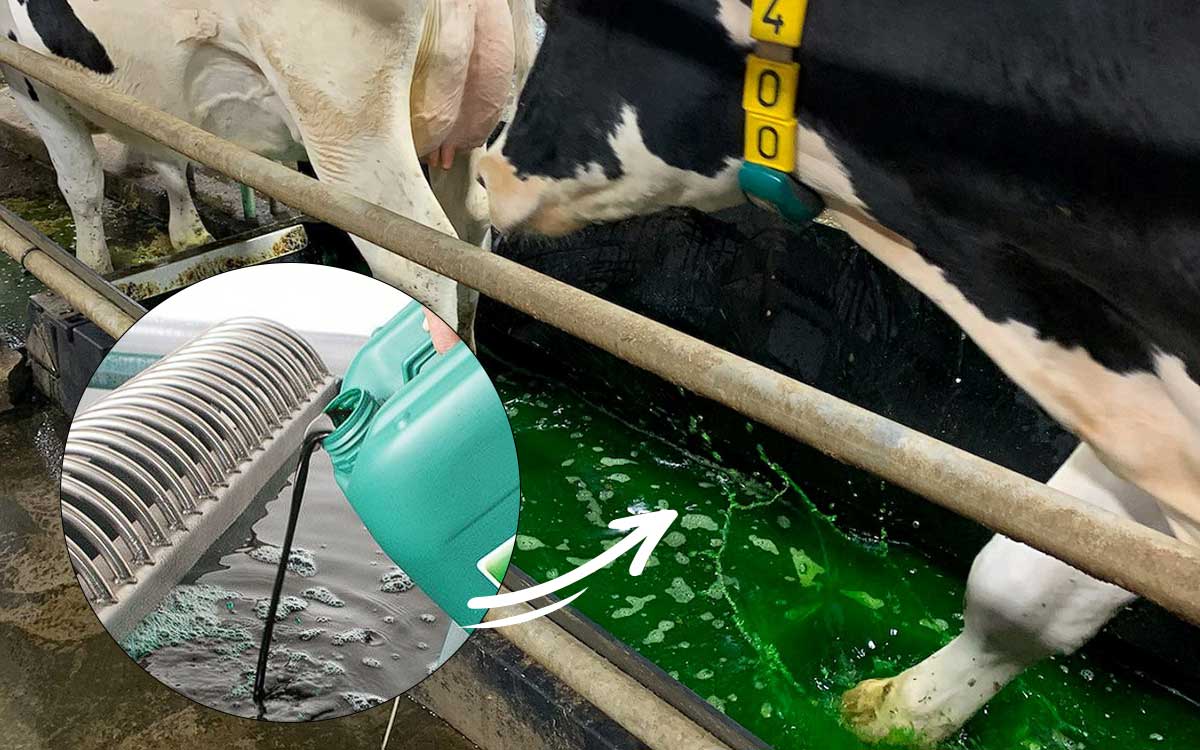Table of Contents
Cows rely on their hooves to support their weight and move around, making hoof health a vital aspect of their overall well-being. Cracked hooves can cause immense pain and discomfort for them, affecting their ability to walk and overall productivity. In this article, I will explore some practical methods for treating cracked hooves in cows, ensuring their optimal health and happiness.
Hoof cracks in a cow are caused by improper trimming, poor nutrition, infectious diseases, or environmental conditions. Regular trimming, balanced nutrition, and preventive measures are key. Prompt attention is crucial for deep cracks, lameness, bleeding, or infection. Consult your hoof trimmer for tailored care and prevention.
Table of Contents
What is a Cracked Hoof?
It is essential to know the definition of a cracked hoof and establish the proper diagnosis. I often get a phone call from farmers with one sentence: ‘My cow’s hoof is cracked, and she is limping. What can I do?’. This question and description sound obvious, but we can go in various directions with this. The apparent crack that is noticed could be different from the vocabulary used by hoof trimmers or veterinarians.
Types of Hoof Cracks
Below are a few versions of the hoof diseases that have been labeled as cracks but should have a little clarification:White line defect
The sole and wall horn are separated, and there is a crack showing on the sole’s white line. Often, this goes together with a separation on the coronary band or hairline.Crack at the hairline
Digital Dermatitis often causes this scenario in the front of the interdigital space. The crack shows between the toes, and the corium bulges out through the opening in further stages. The cow also moves her weight towards the heel, and these toes start growing long quickly.Double sole
A crack is visible in the heel of the hoof, and the sole is separated from the corium.Horizontal wall crack
Shows a crack or growth ring perpendicular to the coronary band or hairline. If these are deep enough on an overgrown hoof and present towards the toe area, the hoof might break off and cause severe lameness.Vertical wall crack
This type of crack is often seen in extremely dry environments and often in beef cows. The track is vertical to the sole line.Injury
I have seen cases where the hoof got cracked like a nut in a nutcracker. The alley manure scraper got a hold of the hoof at the wrong time and split the entire hoof open. Due to the nature of these cracks, I will skip them in the rest of this article.4 Possible Causes of Hoof Cracks
Above, I shared the description of what a cracked hoof can look like, and where these hoof disorders can appear. Below, I will describe some possible causes for the different types of cracks.
Improper Hoof Trimming
Just like human nails, cow hooves grow continuously. They can become excessively long and cause hoof defects or unnecessary stress on the hooves and ligaments if left untrimmed. Regular hoof trimming is essential to prevent this issue. It helps maintain the proper shape and length of the hooves, minimizing the risk of cracks.
Hoof trimming is a skilled practice that involves carefully removing excess hoof material. This process is typically done using specialized tools such as hoof knives and electric hoof grinders. The professional trimmer must have a keen eye to identify any irregularities or abnormalities in the hooves that may contribute to cracking.
During trimming, the trimmer will carefully shape the hooves to ensure an even weight distribution. This is important because uneven weight distribution can put excessive stress on specific areas of the hooves, making them more prone to double soles and sole ulcers. By maintaining proper balance and alignment, hoof trimming helps prevent problems from forming and promotes overall hoof health.
Over-trimming is also very important to mention. When too much horn is removed on the sole or wall areas, the white line area comes under unnecessary stress and will separate. The cracks in the hoof will be extremely painful and could’ve been avoided. Please do not over-trim a hoof.
Poor Nutrition
Another factor that can contribute to hoof cracks is poor nutrition. A well-balanced diet plays a crucial role in the overall health of your cattle, including the condition of their hooves. Nutritional deficiencies, such as a lack of essential minerals and vitamins, can weaken the hoof structure, making it more susceptible to cracking or other hoof problems.
Cows require a balanced diet that includes a variety of nutrients to support their overall health. As a hoof trimmer, I often referred back to the farm’s nutritionist, who reviewed the hoof-trimming records of our last session. Teamwork between these professions is essential.
I always advise my clients to work with their veterinarian or animal nutritionist to develop a proper forage plan that meets the specific nutritional needs of their cows. Regular monitoring of the cows’ body condition and hoof health can help identify any nutritional deficiencies and make necessary adjustments to prevent hoof problems.

Infectious Hoof Diseases
Hoof diseases, such as foot rot and digital dermatitis, can also contribute to the development of cracks in cow hooves. These diseases weaken the hoof structure, making them more susceptible to cracks. Regular monitoring and prompt treatment of infectious hoof diseases are essential to prevent and manage lasting damage to the hooves.
Foot rot, caused by bacteria, is a common infectious hoof disease that can lead to the separation of the inner hoof wall. The crack in the hoof is very painful and pinches the infected interdigital space. The bacteria invade the hoof tissue, causing inflammation and tissue damage. Regular hoof inspections and early detection of foot rot can help prevent its spread and minimize the risk of lasting damage.
Digital dermatitis, also known as hairy heel warts, is another infectious hoof disease that can contribute to cracks in the hoof. It is caused by a bacteria called Treponema, which thrives in moist and unsanitary environments. The bacteria invade the skin around the hooves, causing painful lesions and weakening the hoof structure. The most common area for the cracks to appear is located on the front of the hoof. Proper hygiene and timely foot baths or spraying sessions can help prevent the development of digital dermatitis and reduce the risk of these types of hoof cracks. Treatment of the early stages of Digital Dermatitis will prevent the disease from developing further, and indirectly, you’ll save the hoof from these hard-to-treat cracks.

Hoof-fit Gel
Environmental Factors
The environment in which cows are kept can significantly impact their hoof health. Exposure to damp and unsanitary conditions can soften the hooves and make them more prone to hoof problems, especially infectious hoof diseases. Also, rough and uneven terrain can put excessive stress on the hooves, which leads to excessive pressure on the white line area. Providing clean and dry bedding, as well as maintaining flooring, can help prevent hoof cracks caused by adverse environmental conditions.
Abrasive floors prevent cows from slipping and falling, but they can be a nightmare for the hoof. Excessive wear and possible pebbles or rocks can easily penetrate the white line on the sole and wedge themselves into the horn, causing it to show a crack or separation. When cows walk on uneven surfaces, the hooves are subjected to uneven pressure and stress. Regular pasture maintenance and removal of debris create a more hoof-friendly environment and reduce the risk of cracks.
Should You Be Worried About a Hoof Crack?
Every hoof crack in a cow’s hoof should be a cause for attention, but the severity of the crack depends on various factors. Understanding these factors can help determine when immediate attention is necessary, either by a hoof trimmer or a veterinarian.Location and Depth
One important factor to consider is the location and depth of the crack. Superficial cracks that do not penetrate the hoof are generally not the cause of immediate concern. These cracks usually do not cause discomfort to the cow. However, cracks that extend deep into the sensitive tissues of the hoof are more worrisome. These cracks can expose the sensitive tissues (exposed corium) to potential infections and may cause pain and lameness.

In my experience, I will be very worried about a Digital Dermatitis lesion on the front of the hoof. These lesions affect the coronary band (hairline), and the wall horn production could be interrupted, whereby a hoof crack is formed. These cracks are sometimes called ‘hairy attacks’. Speedy treatment and attention for these lesions is of utmost importance to avoid permanent damage.
When a crack penetrates deep into the hoof, it is essential to seek prompt attention from a professional hoof trimmer or veterinarian. They can assess the severity of the crack and provide appropriate treatment to prevent further complications.
A Limping Animal
If a cow with a cracked hoof is limping or exhibiting signs of lameness, it is an indication that the crack is causing discomfort and pain. Lameness can significantly impact their mobility and overall welfare. Any limping cow should be promptly examined to determine the cause and provide appropriate treatment.
When a cow limps due to a hoof crack, it is crucial to address the issue promptly to alleviate the cow’s pain and prevent further complications. Delaying treatment can lead to additional stress on the cow’s other limbs and joints, potentially causing different lameness issues.
Bleeding or Infection
Bleeding or signs of infection, such as pus or a foul odor, are red flags that the hoof crack has become infected and requires immediate attention by a professional. These complications can lead to more significant health issues if left untreated, so prompt action is necessary.
When a hoof crack becomes infected, it can result in a condition called septic laminitis, which is a severe and painful inflammation of the hoof tissues. This condition can be debilitating and requires intensive treatment to prevent further damage to the cow’s hoof and overall health.
Recurring Cracks
If a cow’s hooves repeatedly develop cracks, it indicates an underlying issue that needs to be addressed. Recurring cracks can be a sign of a nutritional imbalance, chronic infection, or improper hoof care. Identifying and resolving the root cause is crucial to prevent recurrent hoof cracks and ensure the cow’s long-term hoof health.
When a cow (or more animals in the herd) experiences recurring hoof cracks, a comprehensive evaluation of their diet, environment, and overall health is necessary. Implementing appropriate changes can promote healthier hooves and reduce the likelihood of future cracks.
Treating Cracked Hooves
Based on the severity and the diagnosis, I advise you to contact your hoof trimmer or veterinarian if you are unsure about the steps you should take. Below, I give some general tips to treat the hoof cracks that you are observing without seeing them. To describe it as a definite step-by-step protocol is not my intention, but below are some pointers that are pointing you in the right direction.Treating Digital Dermatitis
When dealing with a crack in the hoof caused by a Digital Dermatitis (DD) lesion, it’s essential to address it promptly to maintain your animal’s health. In my career, I found the following steps work the best:
- Trim the crack away: Completely trim away the crack in the hoof. This will help ensure faster healing and prevent pressure on the exposed corium.
- Treat the DD lesion: Apply Intra Hoof-fit Gel to the lesion area. This product is designed to support the healing process and is highly recommended for treating DD lesions.
- Follow up after 3 days: It’s crucial to keep an eye on the lesion and its progress. After three days, remove the wrap and check the healing process. Don’t hesitate to treat the lesion again if it hasn’t healed fully.
- Act promptly: The sooner you detect and treat the lesion, the better the chances of avoiding long-term damage to your animal’s hoof wall.
Remember, speed and early treatment are crucial to ensuring the well-being of your livestock. I’m here to help and support you every step of the way in maintaining the health of your animals.
Trimming Hoof Cracks
Having healthy hooves is critical to prevent and manage hoof cracks. By regularly trimming or checking your cows’ hooves, you help maintain the perfect hoof shape, reducing pressure and lowering the risk of cracks.
When trimming hooves, there are a few essential factors to remember. First up, how often you trim matters. To keep hooves in great shape and prevent cracks, you should know how often do cows need their hooves trimmed. They should be trimmed or checked at least twice a year.
Professional hoof trimmers have the skills and experience to trim the hooves in a way that promotes the best hoof health.
Consulting veterinarian or hoof trimmer
When treating cracked hooves in cows, there are many options to consider. It is to always talk to a vet or hoof trimmer first. They’re the experts who can look at the severity of the hoof cracks, detect if there’s anything else affecting your cow, and offer a treatment plan tailored to your cow’s specific needs. Moreover, they can guide you in preventing these hoof problems in the future. Together, they can always make sure your cows are happily moving along!
How Do You Stop a Cow Hoof From Cracking?
Stopping hoof cracks starts with prevention, but timely action will ensure that the cracks do no further damage. Hoof trimming will provide proper weight distribution and prevent cracks in the white line. Digital Dermatitis prevention through footbaths or spraying will avoid hoof cracks in the front of the hoof.Proper hoof trimming
Various trimming methods will help the cow walk better and avoid hoof cracking. I did my professional hoof trimmer training in Oenkerk, The Netherlands, where the ‘Dutch Trimming Method’ is taught. Hoof cracks in the white line area are often corrected when a hoof is balanced. To stop this white line area crack from escalating into a bigger problem, pair down the sole area and shift the cow’s weight to the adjacent claw.
Use foot baths or spraying
Foot baths with Hoof Sol Bath are a preventive measure to limit the spread of hoof infections in a herd. The spraying method with Hoof Sol Spray is a more targeted approach whereby every cow gets a clean solution. Implementing a regular foot bathing routine can help keep the hooves healthy and decrease the likelihood of cracks developing. Early detection of hoof cracks is better spotted when the cows get sprayed.

Hoof Sol Spray
Aside from foot baths or spraying, maintaining good hygiene practices in the barn is crucial. Regular cleaning of the barn floor and bedding can help prevent the buildup of bacteria and reduce the risk of hoof infections. Furthermore, providing cows with a well-balanced diet that meets their nutritional needs can contribute to overall hoof health and reduce the likelihood of cracks.
Overall, preventing and managing hoof cracks in cows requires a combination of proper hoof trimming techniques, regular foot baths or spraying sessions, and maintaining a clean and comfortable environment.
Frequently Asked Questions about Hoof Cracks
How long does it take for a hoof crack to heal?
The healing time for a hoof crack can vary depending on several factors. The severity of the crack plays a significant role in determining the healing time. Superficial cracks, which only affect the outer layers of the hoof, may heal within a few weeks with proper care and treatment. Deeper cracks may require several months for complete healing. During this time, it is crucial to provide proper hoof care, maintain a clean and dry environment, and regularly monitor the cow’s progress.
How easy is it to trim hoof cracks?
Trimming hoof cracks is complex. The hoof wall horn is very hard, and precise skill with tools like sharp hoof knives is needed. I recommended to seek professional help to ensure the job is done right.
Conclusion
Cracked hooves can significantly impact cows’ well-being, mobility, productivity, and overall health. Understanding the causes of hoof cracks and implementing effective treatment methods are crucial steps in ensuring the optimal hoof health of your herd. Through regular hoof trimming, addressing nutritional deficiencies, and consulting with veterinarians and professional trimmers, you can minimize the occurrence of hoof cracks and provide the necessary care to keep our cows healthy and thriving.
Don’t let hoof cracks compromise the health and productivity of your herd. Join the Diamond Hoof Care newsletter and receive my “Hoof Clips” insights. Benefit from out-of-the-field tips and discover success stories that can inspire your hoof care practices. Sign up to get our Hoof Clips news delivered straight to your inbox, free of charge, and ensure you’re always one step ahead in dairy hoof health management.




